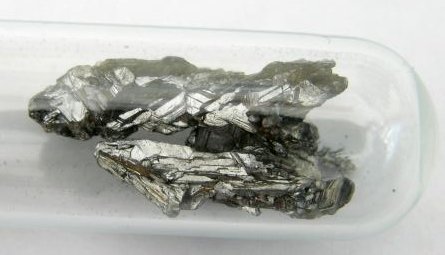Navigation
U.S. EPA Strengthens Chemical Assessment Process to Protect Public Health
The U.S. Environmental Protection Agency (EPA) today announced changes to its Integrated Risk Information System (IRIS) Program to improve the scientific foundation of assessments. IRIS is a human health assessment program that evaluates information on health effects that may result from exposure to environmental contaminants.
 IRIS
IRIS
.JPG)
The U.S. Environmental Protection Agency (EPA) today announced changes to its Integrated Risk Information System (IRIS) Program to improve the scientific foundation of assessments, increase transparency in the program and the process and allow the agency to produce more IRIS assessments each year.
IRIS is a human health assessment program that evaluates information on health effects that may result from exposure to environmental contaminants.
These high quality, science based health assessments are used to inform decisions to protect public health and the environment.
“EPA is committed to producing high quality scientific assessments in a timely and transparent manner,” said Lek Kadeli, principal deputy assistant administrator of EPA’s Office of Research and Development. “The improvements announced today will further strengthen our IRIS assessments and enable the agency to better protect human health and the environment by completing more health assessments for chemicals that are being used across our country every day.”
 Arsenic and its compounds are used in the production of pesticides, treated wood products, herbicides, and insecticides.: These applications are declining, however. Arsenic is notoriously poisonous to multicellular life, although a few species of bacteria are able to use arsenic compounds as respiratory metabolites. Arsenic contamination of groundwater is a problem that affects millions of people across the world. Text and photograph courtesy of Wikipedia.
Arsenic and its compounds are used in the production of pesticides, treated wood products, herbicides, and insecticides.: These applications are declining, however. Arsenic is notoriously poisonous to multicellular life, although a few species of bacteria are able to use arsenic compounds as respiratory metabolites. Arsenic contamination of groundwater is a problem that affects millions of people across the world. Text and photograph courtesy of Wikipedia.
 Arsenic burning in the air.: Photograph by Léiem courtesy of WikipediaConsistent with recommendations from the National Research Council, EPA will now begin releasing preliminary materials and hold a public meeting early in the assessment development process to explain the criteria for selecting studies and to ensure that critical research was not omitted. Meeting with the public earlier in the process will result in more timely opportunities for the public to provide input into the assessment and comment on the information available for each chemical assessed.
Arsenic burning in the air.: Photograph by Léiem courtesy of WikipediaConsistent with recommendations from the National Research Council, EPA will now begin releasing preliminary materials and hold a public meeting early in the assessment development process to explain the criteria for selecting studies and to ensure that critical research was not omitted. Meeting with the public earlier in the process will result in more timely opportunities for the public to provide input into the assessment and comment on the information available for each chemical assessed.
EPA is also using a new document structure for IRIS assessments that is clearer, more concise and more systematic to make the information more accessible. To improve transparency, the agency is enhancing the IRIS website by providing more detailed information regarding assessment schedules, stakeholder meetings and updates on IRIS progress.
Additionally, the agency is implementing “stopping rules” for IRIS that will provide a cutoff point for accepting new data for individual IRIS assessments and raising scientific issues related to the assessment. With these changes, EPA’s goal is to increase the number of assessments being completed each year and provide more accurate assessment development timelines to the public.
The IRIS database contains crucial information about how and at what level chemicals may impact human health. When combined with exposure information, governments and private entities use IRIS to help characterize the public health risks of chemical substances, thereby supporting risk management decisions designed to protect public health.
What is IRIS?
EPA's Integrated Risk Information System (IRIS) is a human health assessment program that evaluates risk information on effects that may result from exposure to environmental contaminants. Through the IRIS Program, EPA provides the highest quality science-based human health assessments to support the Agency's regulatory activities. The IRIS database contains information for more than 540 chemical substances containing information on human health effects that may result from exposure to various substances in the environment. IRIS is prepared and maintained by the EPA’s National Center for Environmental Assessment (NCEA) within the Office of Research and Development (ORD).
The heart of the IRIS system is its collection of searchable documents that describe the health effects of individual substances and that contain descriptive and quantitative information in the following categories:
· Noncancer effects: Oral reference doses and inhalation reference concentrations (RfDs and RfCs, respectively) for effects known or assumed to be produced through a nonlinear (possibly threshold) mode of action. In most instances, RfDs and RfCs are developed for the noncarcinogenic effects of substances.
· Cancer effects: Descriptors that characterize the weight of evidence for human carcinogenicity, oral slope factors, and oral and inhalation unit risks for carcinogenic effects. Where a nonlinear mode of action is established, RfD and RfC values may be used.
What substances are in IRIS?
A complete alphabetical list of the substances in IRIS is available at the A to Z List of IRIS Substances on the left navigation bar. Use Search the IRIS Database by substance name or CASRN to search for IRIS assessments for a specific substance. Other specific search criteria are available as well. You can also search multiple substances at once using Compare IRIS Values.
How do I contact the IRIS Hotline?
Contact the IRIS Hotline via the Contact us page or at (202) 566-1676 (phone), (202) 566-1749 (fax), or hotline.iris@epa.gov (email).
Washington DC 20460 · +1-2025644355
More information about IRIS: http://www.epa.gov/iris
More information about the IRIS process: http://www.epa.gov/iris/process.htm
http://www.epa.gov/iris/pdfs/IRIS_PROCESS_FLOW_CHART.PDF
This news is from the U.S. Environmental Protection Agency (EPA), 31 July 2013.
Posted on the Horizon International Solutions Site 31 July 2013.
Search
Latest articles
Agriculture
- World Water Week: Healthy ecosystems essential to human health: from coronavirus to malnutrition Online session Wednesday 24 August 17:00-18:20
- World Water Week: Healthy ecosystems essential to human health: from coronavirus to malnutrition Online session Wednesday 24 August 17:00-18:20
Air Pollution
- "Water and Sanitation-Related Diseases and the Changing Environment: Challenges, Interventions, and Preventive Measures" Volume 2 Is Now Available
- Global Innovation Exchange Co-Created by Horizon International, USAID, Bill and Melinda Gates Foundation and Others
Biodiversity
- It is time for international mobilization against climate change
- World Water Week: Healthy ecosystems essential to human health: from coronavirus to malnutrition Online session Wednesday 24 August 17:00-18:20
Desertification
- World Water Week: Healthy ecosystems essential to human health: from coronavirus to malnutrition Online session Wednesday 24 August 17:00-18:20
- UN Food Systems Summit Receives Over 1,200 Ideas to Help Meet Sustainable Development Goals
Endangered Species
- Mangrove Action Project Collaborates to Restore and Preserve Mangrove Ecosystems
- Coral Research in Palau offers a “Glimmer of Hope”
Energy
- Global Innovation Exchange Co-Created by Horizon International, USAID, Bill and Melinda Gates Foundation and Others
- Wildlife Preservation in Southeast Nova Scotia
Exhibits
- Global Innovation Exchange Co-Created by Horizon International, USAID, Bill and Melinda Gates Foundation and Others
- Coral Reefs
Forests
- NASA Satellites Reveal Major Shifts in Global Freshwater Updated June 2020
- Global Innovation Exchange Co-Created by Horizon International, USAID, Bill and Melinda Gates Foundation and Others
Global Climate Change
- It is time for international mobilization against climate change
- It is time for international mobilization against climate change
Global Health
- World Water Week: Healthy ecosystems essential to human health: from coronavirus to malnutrition Online session Wednesday 24 August 17:00-18:20
- More than 400 schoolgirls, family and teachers rescued from Afghanistan by small coalition
Industry
- "Water and Sanitation-Related Diseases and the Changing Environment: Challenges, Interventions, and Preventive Measures" Volume 2 Is Now Available
- Global Innovation Exchange Co-Created by Horizon International, USAID, Bill and Melinda Gates Foundation and Others
Natural Disaster Relief
- STOP ATTACKS ON HEALTH CARE IN UKRAINE
- Global Innovation Exchange Co-Created by Horizon International, USAID, Bill and Melinda Gates Foundation and Others
News and Special Reports
- World Water Week: Healthy ecosystems essential to human health: from coronavirus to malnutrition Online session Wednesday 24 August 17:00-18:20
- STOP ATTACKS ON HEALTH CARE IN UKRAINE
Oceans, Coral Reefs
- World Water Week: Healthy ecosystems essential to human health: from coronavirus to malnutrition Online session Wednesday 24 August 17:00-18:20
- Mangrove Action Project Collaborates to Restore and Preserve Mangrove Ecosystems
Pollution
- Zakaria Ouedraogo of Burkina Faso Produces Film “Nzoue Fiyen: Water Not Drinkable”
- "Water and Sanitation-Related Diseases and the Changing Environment: Challenges, Interventions, and Preventive Measures" Volume 2 Is Now Available
Population
- "Water and Sanitation-Related Diseases and the Changing Environment: Challenges, Interventions, and Preventive Measures" Volume 2 Is Now Available
- "Water and Sanitation-Related Diseases and the Changing Environment: Challenges, Interventions, and Preventive Measures" Volume 2 Is Now Available
Public Health
- Honouring the visionary behind India’s sanitation revolution
- Honouring the visionary behind India’s sanitation revolution
Rivers
- World Water Week: Healthy ecosystems essential to human health: from coronavirus to malnutrition Online session Wednesday 24 August 17:00-18:20
- Mangrove Action Project Collaborates to Restore and Preserve Mangrove Ecosystems
Sanitation
- Honouring the visionary behind India’s sanitation revolution
- Honouring the visionary behind India’s sanitation revolution
Toxic Chemicals
- "Water and Sanitation-Related Diseases and the Changing Environment: Challenges, Interventions, and Preventive Measures" Volume 2 Is Now Available
- Actions to Prevent Polluted Drinking Water in the United States
Transportation
- "Water and Sanitation-Related Diseases and the Changing Environment: Challenges, Interventions, and Preventive Measures" Volume 2 Is Now Available
- Urbanization Provides Opportunities for Transition to a Green Economy, Says New Report
Waste Management
- Honouring the visionary behind India’s sanitation revolution
- Honouring the visionary behind India’s sanitation revolution
Water
- Honouring the visionary behind India’s sanitation revolution
- Honouring the visionary behind India’s sanitation revolution
Water and Sanitation
- Honouring the visionary behind India’s sanitation revolution
- Honouring the visionary behind India’s sanitation revolution

